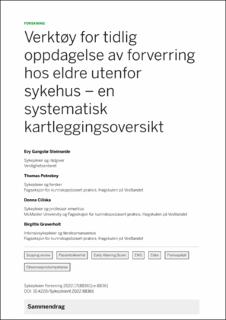| dc.contributor.author | Steinseide, Evy Gangstø | |
| dc.contributor.author | Potrebny, Thomas | |
| dc.contributor.author | Ciliska, Donna | |
| dc.contributor.author | Graverholt, Birgitte | |
| dc.date.accessioned | 2022-10-25T10:30:32Z | |
| dc.date.available | 2022-10-25T10:30:32Z | |
| dc.date.created | 2022-04-06T12:41:00Z | |
| dc.date.issued | 2022 | |
| dc.identifier.citation | Steinseide, E. G., Potrebny, T., Ciliska, D., & Graverholt, B. (2022). Systems for early detection of clinical deterioration in older people in non-hospital settings – a systematic scoping review. Sykepleien Forskning, 17(88361), e-88361. | en_US |
| dc.identifier.issn | 1890-2936 | |
| dc.identifier.uri | https://hdl.handle.net/11250/3028153 | |
| dc.description.abstract | Background: Many older people are vulnerable and extra prone to clinical deterioration. Healthcare personnel therefore need to be extremely skilled in observation. Tools for early detection of clinical deterioration are becoming more common, also in non-hospital settings, but the current evidence base primarily consists of research from hospital populations.
Objective: To find and describe research on tools for early detection of clinical deterioration in older people in non-hospital settings.
Method: In the scoping review, we used the Joanna Briggs Institute’s methodology for scoping reviews, and we published the protocol for the study in the Open Science Framework. A systematic literature search was performed in a relevant selection of databases in May 2021, and this forms the basis for the review. Two people screened all the articles independently according to predefined inclusion and exclusion criteria. We extracted data relating to the research question and summarised and presented these in tables and graphs.
Results: In total, 45 studies are included in the scoping review. In recent years, there has been a marked increase in studies examining the use of tools for early detection of clinical deterioration. A few of these studies have a particular focus on older people, and most deal with the ambulance service. As many as 14 different tools for early detection of clinical deterioration (also known as Early Warning Scores (EWSs)) were identified in the selected studies, the most common of which are MEWS, NEWS and NEWS2. Qualitative studies on the use of such scoring systems may indicate that they are useful as decision support for healthcare personnel who need to assess clinical deterioration in a patient.
Conclusion: This study shows a large increase in the number of studies in recent years on tools for early detection of clinical deterioration in non-hospital settings. The increase may be a reflection of the greater focus on and growing need for such scoring systems in decision support. Nevertheless, there are surprisingly few studies with a particular focus on older people and primary care. This is paradoxical given the weak evidence base of the national clinical guidance that recommends such systems. We recommend use of such systems and prioritisation of the knowledge gap. | en_US |
| dc.language.iso | nob | en_US |
| dc.publisher | Norsk Sykepleierforbund | en_US |
| dc.title | Verktøy for tidlig oppdagelse av forverring hos eldre utenfor sykehus – en systematisk kartleggingsoversikt | en_US |
| dc.type | Peer reviewed | en_US |
| dc.type | Journal article | en_US |
| dc.description.version | publishedVersion | en_US |
| dc.source.pagenumber | 1-24 | en_US |
| dc.source.volume | 17 | en_US |
| dc.source.journal | Sykepleien Forskning | en_US |
| dc.identifier.doi | 10.4220/Sykepleienf.2022.88361 | |
| dc.identifier.cristin | 2015626 | |
| cristin.ispublished | true | |
| cristin.fulltext | original | |
| cristin.qualitycode | 1 | |
